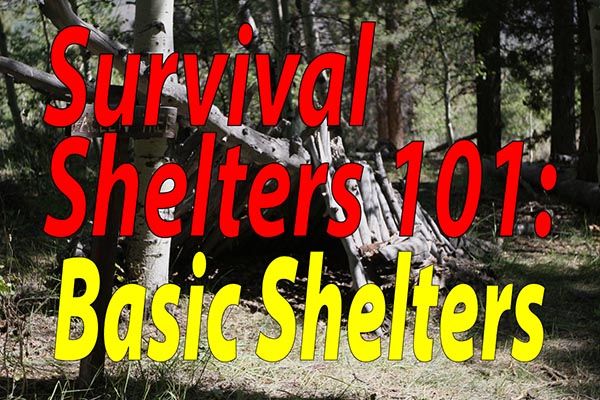
Shelter Basics & Six of the Best Shelters for Any Survival Scenario
 Having a stable shelter in an emergency survival situation can often mean the difference between life and death. So knowing how to build a variety of shelters for a variety of different scenarios is a necessity for anyone wanting to be adequately prepared.
Having a stable shelter in an emergency survival situation can often mean the difference between life and death. So knowing how to build a variety of shelters for a variety of different scenarios is a necessity for anyone wanting to be adequately prepared.
Below, we’ll cover the three things you should always consider before building a survival shelter, the three guidelines for basic shelter construction, and six of the most basic shelters that will adequately protect you in almost any survival situation.
3 Critical Considerations for Building Any Survival Shelter
There are three things you should consider before deciding on a shelter: climate, physical condition, and materials.
The climate. What is the area’s climate? Is it a hot climate, cold climate, rainy climate, or snowy climate? In a hot environment, you’ll want a shelter that protects from the sun and heat. In a cold environment, you’ll want a well-insulated shelter. In a rainy climate, you’ll want a dry shelter.
Your current condition. Are you in good physical condition, or are you injured? If you’re still in good condition, you can exert a little more energy and strength into building your shelter. If you’re hurt, you’ll need a bare-essentials survival shelter (like a lean-to).
Available materials. What materials are available to you? What do you possess that would be useful – a knife, rope, poncho, etc.? And what natural materials in the area can you use – trees, overhangs, branches, rocks, snow drifts, etc.? Always assess your area to see what you have at your disposal.
3 Essential Guidelines for Basic Shelter Construction
Keep it simple. There’s no need to construct an elaborate teepee when all you need is a simple lean-to. Larger shelters most often mean more exerted energy and more upkeep. Remember, you’re not living, but surviving.
Keep it level. Building your shelter on level ground decreases the risk of structural failure – one of the biggest hindrances and morale killers in survival situations. The one exception to this guideline is if you’re in a rainy climate. In which case, you would want a gentle slope for runoff purposes.
Choose the optimal position. Proper positioning of your shelter is crucial. Good positioning will protect you from the elements. For instance, in hot climates, it’s smarter to position your shelter to allow you to feel the breeze. In cold climates, position the shelter to protect your form the wind.
6 Basic Shelters Every Survivalist Should Know How To Construct
Cold Climate Shelters
Snow Cave – The snow cave is the best shelter for a snowy climate. It involves digging a cave in a snow drift, utilizing the snow’s great insulation properties.
How to Construct: How to Build a Snow Cave
Snow Trench – This is a great shelter to use with compacted snow. It involves digging a shallow trench in the snow and constructing a roof using snow blocks. A small opening with a makeshift door helps keep the wind out.
How to Construct: How to Build a Snow Trench Shelter
Rainy Climate Shelters
Lean-To – The classic lean-to shelter is both simple to construct and waterproof. Plus, you can build it out of almost anything. If you have a poncho and some rope, you can have it up in minutes. If not, there are plenty of other lean-to methods available.
How to Construct: Wilderness Survival Shelter – Lean-To
Debris Shelter – A debris shelter is another simple shelter to construct – using a central pole, small sticks, and natural debris. Not only will it keep you dry, but it will also keep you warm.
How to Construct: Survival School Debris Shelter
Hot Climate Shelters
Desert Trench – The desert trench is the most popular shelter for hot, arid climates. It requires a poncho (or equivalent) to construct, but it is very effective at protecting you from both the heat during the day (by providing shade) and the cold during the night (by providing insulation and wind protection).
How to Construct: Building Shelters in Desert for Temperature
Beach Shade – A beach shade provides protection from wind, sun, rain, and heat. It’s very similar to the snow trench, except the sand is used instead of snow. The roof’s frame is constructed out of nearby sticks and other natural materials.
How to Construct: Beach Shade Shelter
If you have any questions or anything to add, please leave them in the comments or on our FaceBook page!
